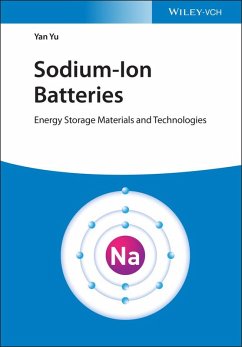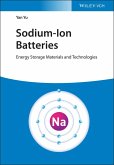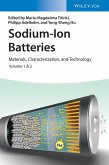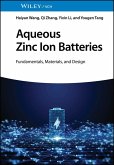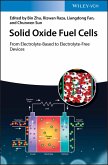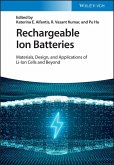171,99 €
171,99 €
inkl. MwSt.
Sofort per Download lieferbar

0 °P sammeln
171,99 €
Als Download kaufen

171,99 €
inkl. MwSt.
Sofort per Download lieferbar

0 °P sammeln
Jetzt verschenken
Alle Infos zum eBook verschenken
171,99 €
inkl. MwSt.
Sofort per Download lieferbar
Alle Infos zum eBook verschenken

0 °P sammeln
- Format: ePub
- Merkliste
- Auf die Merkliste
- Bewerten Bewerten
- Teilen
- Produkt teilen
- Produkterinnerung
- Produkterinnerung

Bitte loggen Sie sich zunächst in Ihr Kundenkonto ein oder registrieren Sie sich bei
bücher.de, um das eBook-Abo tolino select nutzen zu können.
Hier können Sie sich einloggen
Hier können Sie sich einloggen
Sie sind bereits eingeloggt. Klicken Sie auf 2. tolino select Abo, um fortzufahren.

Bitte loggen Sie sich zunächst in Ihr Kundenkonto ein oder registrieren Sie sich bei bücher.de, um das eBook-Abo tolino select nutzen zu können.
This book covers the recent progress of Sodium-Ion Batteries and provides valuable perspectives on designing better materials for SIBs to realize practical applications in the near future.
- Geräte: eReader
- mit Kopierschutz
- eBook Hilfe
- Größe: 148.22MB
Andere Kunden interessierten sich auch für
![Sodium-Ion Batteries (eBook, PDF) Sodium-Ion Batteries (eBook, PDF)]() Yan YuSodium-Ion Batteries (eBook, PDF)171,99 €
Yan YuSodium-Ion Batteries (eBook, PDF)171,99 €![Sodium-Ion Batteries (eBook, ePUB) Sodium-Ion Batteries (eBook, ePUB)]() Sodium-Ion Batteries (eBook, ePUB)259,99 €
Sodium-Ion Batteries (eBook, ePUB)259,99 €![Aqueous Zinc Ion Batteries (eBook, PDF) Aqueous Zinc Ion Batteries (eBook, PDF)]() Haiyan WangAqueous Zinc Ion Batteries (eBook, PDF)133,99 €
Haiyan WangAqueous Zinc Ion Batteries (eBook, PDF)133,99 €![Solid Oxide Fuel Cells (eBook, ePUB) Solid Oxide Fuel Cells (eBook, ePUB)]() Solid Oxide Fuel Cells (eBook, ePUB)160,99 €
Solid Oxide Fuel Cells (eBook, ePUB)160,99 €![Rechargeable Ion Batteries (eBook, ePUB) Rechargeable Ion Batteries (eBook, ePUB)]() Rechargeable Ion Batteries (eBook, ePUB)138,99 €
Rechargeable Ion Batteries (eBook, ePUB)138,99 €![Magnesium-Based Energy Storage Materials and Systems (eBook, ePUB) Magnesium-Based Energy Storage Materials and Systems (eBook, ePUB)]() Jianxin ZouMagnesium-Based Energy Storage Materials and Systems (eBook, ePUB)115,99 €
Jianxin ZouMagnesium-Based Energy Storage Materials and Systems (eBook, ePUB)115,99 €![Towards Next Generation Energy Storage Technologies (eBook, ePUB) Towards Next Generation Energy Storage Technologies (eBook, ePUB)]() Towards Next Generation Energy Storage Technologies (eBook, ePUB)142,99 €
Towards Next Generation Energy Storage Technologies (eBook, ePUB)142,99 €-
-
-
This book covers the recent progress of Sodium-Ion Batteries and provides valuable perspectives on designing better materials for SIBs to realize practical applications in the near future.
Dieser Download kann aus rechtlichen Gründen nur mit Rechnungsadresse in A, B, BG, CY, CZ, D, DK, EW, E, FIN, F, GR, HR, H, IRL, I, LT, L, LR, M, NL, PL, P, R, S, SLO, SK ausgeliefert werden.
Produktdetails
- Produktdetails
- Verlag: Wiley-VCH
- Seitenzahl: 544
- Erscheinungstermin: 14. Februar 2022
- Englisch
- ISBN-13: 9783527831630
- Artikelnr.: 67715986
- Verlag: Wiley-VCH
- Seitenzahl: 544
- Erscheinungstermin: 14. Februar 2022
- Englisch
- ISBN-13: 9783527831630
- Artikelnr.: 67715986
- Herstellerkennzeichnung Die Herstellerinformationen sind derzeit nicht verfügbar.
Yan Yu is a Full Professor of material science in University of Science and Technology of China (USTC). Her current research interests mainly include design of novel nanomaterials for clean energy, especially for batteries and the fundamental science of energy storage system. She has published more than 200 articles in international journals. These papers have been cited nearly 10000 times. She has received numerous scientific awards, including the Sofja Kovalevskaja Award of Alexander von Humboldt Foundation and the Wiley Small Young Innovator Award.
Foreword
Preface
1 INTRODUCTION TO SODIUM-ION BATTERIES
1.1 Brief Outline
1.2 Key Materials
1.3 Toward Future Development
2 DESIGN PRINCIPLES FOR SODIUM-ION BATTERIES
2.1 Introduction
2.2 Basic Design Principles
2.3 Design Principles for Electrode Materials
2.4 Design Principles for Electrolytes
2.5 Conclusions
3 TRANSITION METAL OXIDE CATHODES FOR SODIUM-ION BATTERIES
3.1 Introduction
3.2 Sodium-Free Transition Metal Oxides
3.3 Sodium-Inserted Layered Metal Oxides
3.4 Concluding Remarks
4 POLYANION-TYPE CATHODES FOR SODIUM-ION BATTERIES
4.1 Introduction
4.2 Phosphates
4.3 Pyrophosphates
4.4 Fluorinated Phosphate Cathodes
4.5 Sulfates
4.6 Silicates
4.7 Other Polyanion-Type Compounds
4.8 Concluding Remarks
5 PRUSSIAN BLUE ANALOGUE CATHODES FOR SODIUM-ION BATTERIES
5.1 Introduction
5.2 Crystal Structure
5.3 Electrochemistry Mechanisms
5.4 Preparation Approaches
5.5 Optimizing Electrochemical Performance
5.6 Concluding Remarks
6 ORGANIC CATHODES FOR SODIUM-ION BATTERIES
6.1 Introduction
6.2 C=O Reaction
6.3 Doping Reaction
6.4 C=N Reaction
6.5 Concluding Remarks
7 INTERCALATION-TYPE ANODE MATERIALS FOR SODIUM-ION BATTERIES
7.1 Introduction
7.2 Carbon-Based Anode Materials
7.3 Titanium-Based Anode Materials
8 PHOSPHORUS/PHOSPHIDE ANODES FOR SODIUM-ION BATTERIES ON ALLOY AND CONVERSION REACTIONS
8.1 Introduction
8.2 Phosphorus Anodes
8.3 Metal Phosphide Anodes
9 METAL OXIDES/CHALCOGENIDES/ALLOYS FOR SODIUM-ION BATTERIES ON ALLOY AND CONVERSION REACTIONS
9.1 Introduction
9.2 Metal Oxides
9.3 Metal Chalcogenides
9.4 Metal Alloys
10 EFFECTIVE STRATEGIES TO RESTRAIN DENDRITE GROWTH OF NA METAL ANODES
10.1 Introduction
10.2 Liquid Electrolyte Optimization for Na Metal Anodes
10.3 Construction of Novel Current Collectors for Na Metal Anodes
10.4 Alloy-Based Na Metal Anodes
10.5 Conclusions
11 ORGANIC LIQUID ELECTROLYTES FOR SODIUM-ION BATTERIES
11.1 Introduction
11.2 Electrolyte Properties
11.3 Sodium Salts
11.4 Solvents
11.5 Functional Additives
11.6 Novel Concentration Electrolyte Systems
12 IONIC LIQUID ELECTROLYTES FOR SODIUM-ION BATTERIES
12.1 Introduction
12.2 The Cationic Species in Ionic Liquids
12.3 The Anionic Species in Ionic Liquids
12.4 Electrolyte Properties
12.5 Stability of Ionic Liquids
12.6 Concluding Remarks
13 SOLID STATE AND GEL ELECTROLYTES FOR SODIUM-ION BATTERIES
13.1 Introduction
13.2 Energy Density
13.3 Electrolyte Characteristics
13.4 Polymer Electrolytes
13.5 Inorganic Solid-State Electrolytes
14 BINDERS FOR SODIUM-ION BATTERIES
14.1 Introduction
14.2 Main Functions and Performance Requirements of Binders
14.3 Polyvinylidene Fluoride (PVDF)
14.4 Polyacrylic Acid (PAA)
14.5 Carboxymethyl Cellulose (CMC)
14.6 Styrene Butadiene Rubber (SBR)
14.7 Other Binders
15 SODIUM-ION FULL BATTERIES
15.1 Introduction
15.2 Aqueous Sodium-Ion Full Batteries
15.3 Non-Aqueous Sodium-Ion Full Batteries
15.4 Solid-State Sodium-Ion Full Batteries
16 PERSPECTIVES FOR SODIUM-ION BATTERIES
Preface
1 INTRODUCTION TO SODIUM-ION BATTERIES
1.1 Brief Outline
1.2 Key Materials
1.3 Toward Future Development
2 DESIGN PRINCIPLES FOR SODIUM-ION BATTERIES
2.1 Introduction
2.2 Basic Design Principles
2.3 Design Principles for Electrode Materials
2.4 Design Principles for Electrolytes
2.5 Conclusions
3 TRANSITION METAL OXIDE CATHODES FOR SODIUM-ION BATTERIES
3.1 Introduction
3.2 Sodium-Free Transition Metal Oxides
3.3 Sodium-Inserted Layered Metal Oxides
3.4 Concluding Remarks
4 POLYANION-TYPE CATHODES FOR SODIUM-ION BATTERIES
4.1 Introduction
4.2 Phosphates
4.3 Pyrophosphates
4.4 Fluorinated Phosphate Cathodes
4.5 Sulfates
4.6 Silicates
4.7 Other Polyanion-Type Compounds
4.8 Concluding Remarks
5 PRUSSIAN BLUE ANALOGUE CATHODES FOR SODIUM-ION BATTERIES
5.1 Introduction
5.2 Crystal Structure
5.3 Electrochemistry Mechanisms
5.4 Preparation Approaches
5.5 Optimizing Electrochemical Performance
5.6 Concluding Remarks
6 ORGANIC CATHODES FOR SODIUM-ION BATTERIES
6.1 Introduction
6.2 C=O Reaction
6.3 Doping Reaction
6.4 C=N Reaction
6.5 Concluding Remarks
7 INTERCALATION-TYPE ANODE MATERIALS FOR SODIUM-ION BATTERIES
7.1 Introduction
7.2 Carbon-Based Anode Materials
7.3 Titanium-Based Anode Materials
8 PHOSPHORUS/PHOSPHIDE ANODES FOR SODIUM-ION BATTERIES ON ALLOY AND CONVERSION REACTIONS
8.1 Introduction
8.2 Phosphorus Anodes
8.3 Metal Phosphide Anodes
9 METAL OXIDES/CHALCOGENIDES/ALLOYS FOR SODIUM-ION BATTERIES ON ALLOY AND CONVERSION REACTIONS
9.1 Introduction
9.2 Metal Oxides
9.3 Metal Chalcogenides
9.4 Metal Alloys
10 EFFECTIVE STRATEGIES TO RESTRAIN DENDRITE GROWTH OF NA METAL ANODES
10.1 Introduction
10.2 Liquid Electrolyte Optimization for Na Metal Anodes
10.3 Construction of Novel Current Collectors for Na Metal Anodes
10.4 Alloy-Based Na Metal Anodes
10.5 Conclusions
11 ORGANIC LIQUID ELECTROLYTES FOR SODIUM-ION BATTERIES
11.1 Introduction
11.2 Electrolyte Properties
11.3 Sodium Salts
11.4 Solvents
11.5 Functional Additives
11.6 Novel Concentration Electrolyte Systems
12 IONIC LIQUID ELECTROLYTES FOR SODIUM-ION BATTERIES
12.1 Introduction
12.2 The Cationic Species in Ionic Liquids
12.3 The Anionic Species in Ionic Liquids
12.4 Electrolyte Properties
12.5 Stability of Ionic Liquids
12.6 Concluding Remarks
13 SOLID STATE AND GEL ELECTROLYTES FOR SODIUM-ION BATTERIES
13.1 Introduction
13.2 Energy Density
13.3 Electrolyte Characteristics
13.4 Polymer Electrolytes
13.5 Inorganic Solid-State Electrolytes
14 BINDERS FOR SODIUM-ION BATTERIES
14.1 Introduction
14.2 Main Functions and Performance Requirements of Binders
14.3 Polyvinylidene Fluoride (PVDF)
14.4 Polyacrylic Acid (PAA)
14.5 Carboxymethyl Cellulose (CMC)
14.6 Styrene Butadiene Rubber (SBR)
14.7 Other Binders
15 SODIUM-ION FULL BATTERIES
15.1 Introduction
15.2 Aqueous Sodium-Ion Full Batteries
15.3 Non-Aqueous Sodium-Ion Full Batteries
15.4 Solid-State Sodium-Ion Full Batteries
16 PERSPECTIVES FOR SODIUM-ION BATTERIES
Foreword
Preface
1 INTRODUCTION TO SODIUM-ION BATTERIES
1.1 Brief Outline
1.2 Key Materials
1.3 Toward Future Development
2 DESIGN PRINCIPLES FOR SODIUM-ION BATTERIES
2.1 Introduction
2.2 Basic Design Principles
2.3 Design Principles for Electrode Materials
2.4 Design Principles for Electrolytes
2.5 Conclusions
3 TRANSITION METAL OXIDE CATHODES FOR SODIUM-ION BATTERIES
3.1 Introduction
3.2 Sodium-Free Transition Metal Oxides
3.3 Sodium-Inserted Layered Metal Oxides
3.4 Concluding Remarks
4 POLYANION-TYPE CATHODES FOR SODIUM-ION BATTERIES
4.1 Introduction
4.2 Phosphates
4.3 Pyrophosphates
4.4 Fluorinated Phosphate Cathodes
4.5 Sulfates
4.6 Silicates
4.7 Other Polyanion-Type Compounds
4.8 Concluding Remarks
5 PRUSSIAN BLUE ANALOGUE CATHODES FOR SODIUM-ION BATTERIES
5.1 Introduction
5.2 Crystal Structure
5.3 Electrochemistry Mechanisms
5.4 Preparation Approaches
5.5 Optimizing Electrochemical Performance
5.6 Concluding Remarks
6 ORGANIC CATHODES FOR SODIUM-ION BATTERIES
6.1 Introduction
6.2 C=O Reaction
6.3 Doping Reaction
6.4 C=N Reaction
6.5 Concluding Remarks
7 INTERCALATION-TYPE ANODE MATERIALS FOR SODIUM-ION BATTERIES
7.1 Introduction
7.2 Carbon-Based Anode Materials
7.3 Titanium-Based Anode Materials
8 PHOSPHORUS/PHOSPHIDE ANODES FOR SODIUM-ION BATTERIES ON ALLOY AND CONVERSION REACTIONS
8.1 Introduction
8.2 Phosphorus Anodes
8.3 Metal Phosphide Anodes
9 METAL OXIDES/CHALCOGENIDES/ALLOYS FOR SODIUM-ION BATTERIES ON ALLOY AND CONVERSION REACTIONS
9.1 Introduction
9.2 Metal Oxides
9.3 Metal Chalcogenides
9.4 Metal Alloys
10 EFFECTIVE STRATEGIES TO RESTRAIN DENDRITE GROWTH OF NA METAL ANODES
10.1 Introduction
10.2 Liquid Electrolyte Optimization for Na Metal Anodes
10.3 Construction of Novel Current Collectors for Na Metal Anodes
10.4 Alloy-Based Na Metal Anodes
10.5 Conclusions
11 ORGANIC LIQUID ELECTROLYTES FOR SODIUM-ION BATTERIES
11.1 Introduction
11.2 Electrolyte Properties
11.3 Sodium Salts
11.4 Solvents
11.5 Functional Additives
11.6 Novel Concentration Electrolyte Systems
12 IONIC LIQUID ELECTROLYTES FOR SODIUM-ION BATTERIES
12.1 Introduction
12.2 The Cationic Species in Ionic Liquids
12.3 The Anionic Species in Ionic Liquids
12.4 Electrolyte Properties
12.5 Stability of Ionic Liquids
12.6 Concluding Remarks
13 SOLID STATE AND GEL ELECTROLYTES FOR SODIUM-ION BATTERIES
13.1 Introduction
13.2 Energy Density
13.3 Electrolyte Characteristics
13.4 Polymer Electrolytes
13.5 Inorganic Solid-State Electrolytes
14 BINDERS FOR SODIUM-ION BATTERIES
14.1 Introduction
14.2 Main Functions and Performance Requirements of Binders
14.3 Polyvinylidene Fluoride (PVDF)
14.4 Polyacrylic Acid (PAA)
14.5 Carboxymethyl Cellulose (CMC)
14.6 Styrene Butadiene Rubber (SBR)
14.7 Other Binders
15 SODIUM-ION FULL BATTERIES
15.1 Introduction
15.2 Aqueous Sodium-Ion Full Batteries
15.3 Non-Aqueous Sodium-Ion Full Batteries
15.4 Solid-State Sodium-Ion Full Batteries
16 PERSPECTIVES FOR SODIUM-ION BATTERIES
Preface
1 INTRODUCTION TO SODIUM-ION BATTERIES
1.1 Brief Outline
1.2 Key Materials
1.3 Toward Future Development
2 DESIGN PRINCIPLES FOR SODIUM-ION BATTERIES
2.1 Introduction
2.2 Basic Design Principles
2.3 Design Principles for Electrode Materials
2.4 Design Principles for Electrolytes
2.5 Conclusions
3 TRANSITION METAL OXIDE CATHODES FOR SODIUM-ION BATTERIES
3.1 Introduction
3.2 Sodium-Free Transition Metal Oxides
3.3 Sodium-Inserted Layered Metal Oxides
3.4 Concluding Remarks
4 POLYANION-TYPE CATHODES FOR SODIUM-ION BATTERIES
4.1 Introduction
4.2 Phosphates
4.3 Pyrophosphates
4.4 Fluorinated Phosphate Cathodes
4.5 Sulfates
4.6 Silicates
4.7 Other Polyanion-Type Compounds
4.8 Concluding Remarks
5 PRUSSIAN BLUE ANALOGUE CATHODES FOR SODIUM-ION BATTERIES
5.1 Introduction
5.2 Crystal Structure
5.3 Electrochemistry Mechanisms
5.4 Preparation Approaches
5.5 Optimizing Electrochemical Performance
5.6 Concluding Remarks
6 ORGANIC CATHODES FOR SODIUM-ION BATTERIES
6.1 Introduction
6.2 C=O Reaction
6.3 Doping Reaction
6.4 C=N Reaction
6.5 Concluding Remarks
7 INTERCALATION-TYPE ANODE MATERIALS FOR SODIUM-ION BATTERIES
7.1 Introduction
7.2 Carbon-Based Anode Materials
7.3 Titanium-Based Anode Materials
8 PHOSPHORUS/PHOSPHIDE ANODES FOR SODIUM-ION BATTERIES ON ALLOY AND CONVERSION REACTIONS
8.1 Introduction
8.2 Phosphorus Anodes
8.3 Metal Phosphide Anodes
9 METAL OXIDES/CHALCOGENIDES/ALLOYS FOR SODIUM-ION BATTERIES ON ALLOY AND CONVERSION REACTIONS
9.1 Introduction
9.2 Metal Oxides
9.3 Metal Chalcogenides
9.4 Metal Alloys
10 EFFECTIVE STRATEGIES TO RESTRAIN DENDRITE GROWTH OF NA METAL ANODES
10.1 Introduction
10.2 Liquid Electrolyte Optimization for Na Metal Anodes
10.3 Construction of Novel Current Collectors for Na Metal Anodes
10.4 Alloy-Based Na Metal Anodes
10.5 Conclusions
11 ORGANIC LIQUID ELECTROLYTES FOR SODIUM-ION BATTERIES
11.1 Introduction
11.2 Electrolyte Properties
11.3 Sodium Salts
11.4 Solvents
11.5 Functional Additives
11.6 Novel Concentration Electrolyte Systems
12 IONIC LIQUID ELECTROLYTES FOR SODIUM-ION BATTERIES
12.1 Introduction
12.2 The Cationic Species in Ionic Liquids
12.3 The Anionic Species in Ionic Liquids
12.4 Electrolyte Properties
12.5 Stability of Ionic Liquids
12.6 Concluding Remarks
13 SOLID STATE AND GEL ELECTROLYTES FOR SODIUM-ION BATTERIES
13.1 Introduction
13.2 Energy Density
13.3 Electrolyte Characteristics
13.4 Polymer Electrolytes
13.5 Inorganic Solid-State Electrolytes
14 BINDERS FOR SODIUM-ION BATTERIES
14.1 Introduction
14.2 Main Functions and Performance Requirements of Binders
14.3 Polyvinylidene Fluoride (PVDF)
14.4 Polyacrylic Acid (PAA)
14.5 Carboxymethyl Cellulose (CMC)
14.6 Styrene Butadiene Rubber (SBR)
14.7 Other Binders
15 SODIUM-ION FULL BATTERIES
15.1 Introduction
15.2 Aqueous Sodium-Ion Full Batteries
15.3 Non-Aqueous Sodium-Ion Full Batteries
15.4 Solid-State Sodium-Ion Full Batteries
16 PERSPECTIVES FOR SODIUM-ION BATTERIES
